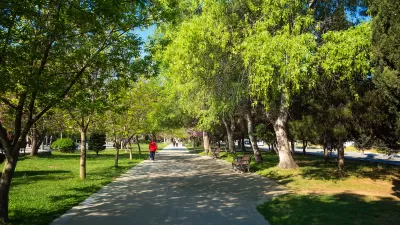The "Active Cities Report" by the Designed to Move coalition provides detailed guidance concerning how to integrate physical activity into community design, and information on the economic, social and environmental benefits that result.

Designed to Move is a coalition of more than 80 public, private, and civil sector organizations dedicated to ending the growing epidemic of physical inactivity. Their newest report, Active Cities: A Guide for City Leaders, provides detailed information concerning why and how to incorporate healthy physical activity into community design.

The report explains:
This is about making our cities more competitive.
The research is clear on this claim. Integrating physical activity into the places we work, live, learn, travel, and play is the only way to ensure we move enough to thrive.
Physical inactivity is bankrupting economies at the national level, but it is felt most acutely by the world's cities—often through negative impacts on the health of people, economies, and the environment. This is bad news for cities and their citizens. The good news is there's a solution.
Our bodies are designed to move. Our cities should be too.
Higher levels of physical activity are associated with positive outcomes for most of the things that matter to city leaders. When people move more, crime, pollution, and traffic go down. Productivity, school performance, property values, health, and well-being improve drastically.
Cities that make physical activity a priority, convert existing spaces into active spaces, and design environments for people to be active will create a legacy of physical activity. These active cities will be better off by almost every possible measure.
Our purpose here is to provide a blueprint for creating active cities, whatever their size and wherever in the world they may be.

This report is based on an extensive body of academic research described in the article, "Co-benefits of Designing Communities for Active Living: An Exploration of Literature," written by a team lead by Dr. James F Sallis, recently published in the International Journal of Behavioral Nutrition and Physical Activity.
FULL STORY: Active Cities Report - A Guide for City Leaders

Alabama: Trump Terminates Settlements for Black Communities Harmed By Raw Sewage
Trump deemed the landmark civil rights agreement “illegal DEI and environmental justice policy.”

Planetizen Federal Action Tracker
A weekly monitor of how Trump’s orders and actions are impacting planners and planning in America.

The 120 Year Old Tiny Home Villages That Sheltered San Francisco’s Earthquake Refugees
More than a century ago, San Francisco mobilized to house thousands of residents displaced by the 1906 earthquake. Could their strategy offer a model for the present?

In Both Crashes and Crime, Public Transportation is Far Safer than Driving
Contrary to popular assumptions, public transportation has far lower crash and crime rates than automobile travel. For safer communities, improve and encourage transit travel.

Report: Zoning Reforms Should Complement Nashville’s Ambitious Transit Plan
Without reform, restrictive zoning codes will limit the impact of the city’s planned transit expansion and could exclude some of the residents who depend on transit the most.

Judge Orders Release of Frozen IRA, IIJA Funding
The decision is a victory for environmental groups who charged that freezing funds for critical infrastructure and disaster response programs caused “real and irreparable harm” to communities.
Urban Design for Planners 1: Software Tools
This six-course series explores essential urban design concepts using open source software and equips planners with the tools they need to participate fully in the urban design process.
Planning for Universal Design
Learn the tools for implementing Universal Design in planning regulations.
Clanton & Associates, Inc.
Jessamine County Fiscal Court
Institute for Housing and Urban Development Studies (IHS)
City of Grandview
Harvard GSD Executive Education
Toledo-Lucas County Plan Commissions
Salt Lake City
NYU Wagner Graduate School of Public Service





























